Civil 3D project version migration to Civil 3D 2018
Last updated: 2021-02-17
 Minimum migration steps per drawing matrix #minimum
Minimum migration steps per drawing matrix #minimum
The following table shows common files from Project data workflow map with migration steps for each file.
X = Required.
O = Optional. Required for DWGs with pipe networks.
| Folder | Drawing | Description | Clean and fix | Save to Civil 3D 2018 | Convert to CTB | Update layers | Update pipe networks | Import updated styles | Cross sections: Drafting buffers | Section view & group plot styles | Add Civil 3D 2018 updated components | Insert page setup and update layouts | Corridor drawings |
|---|---|---|---|---|---|---|---|---|---|---|---|---|---|
| BaseData | Topo-Ex.dwg | Existing topography for plans | X | X | X | X | X | ||||||
| Uti-Ex.dwg | Existing utilities for plans | X | X | X | X | X | |||||||
| Surf-Ex.dwg | Existing surface | X | X | ||||||||||
| BaseData-Mapping | M (Flight).dwg | Existing mapping topo | X | X | X | X | |||||||
| BaseData-Other | USGS DEM surface | For drainage analysis | X | X | |||||||||
| Existing pipe network | Model of existing facilities | X | X | X | |||||||||
| BaseData-Survey | SurveyEdits.dwg | Field survey edit file | X | X | |||||||||
| Topo-Ex-Survey.dwg | Existing survey topo | X | X | X | X | X | |||||||
| Surf-Ex-Survey.dwg | Existing survey surface | X | X | ||||||||||
| SurvCtrl.dwg | Field control data | X | X | X | X | X | |||||||
| Design\AliProf | AliProf-<Road>.dwg | Alignments and profiles | X | X | |||||||||
| Design\Corridors | Crdr-<Road>.dwg | Corridor (s) | X | X | X | ||||||||
| Design\Edgelines | pavt.dwg | Proposed pavements | X | X | X | X | |||||||
| SI.dwg | Proposed slope intercepts | X | X | X | X | ||||||||
| PM.dwg | Pavement marking | X | X | X | X | ||||||||
| Design\Surfaces | Surf-Rfnt-All-Top.dwg | Top refinement surfaces | X | X | |||||||||
| Surf-Rfnt-All-Datum.dwg | Datum refinement surfaces | X | X | ||||||||||
| Surf-Cmbn-Ex-Top.dwg | Combined existing and proposed top | X | X | ||||||||||
| Surf-Cmbn-Ex-Datum.dwg | Combined existing and proposed datum | X | X | ||||||||||
| RuralDwy.dwg | Rural driveway grading | X | X | ||||||||||
| Design\PipeNetworks | Pipe-Culverts.dwg | Proposed culvert design | X | X | X | ||||||||
| Pipe-StormSewer.dwg | Proposed storm sewer | X | X | X | |||||||||
| Design\Quantities | Quantities.dwg | Document length and area measurements | X | X | |||||||||
| Earthwork-<Road>.dwg | Earthwork calculation drawings | X | X | ||||||||||
| RW | Ult-RW.dwg | Combination of exist and proposed RW | X | X | X | X | X | ||||||
| SheetsPlan | Non Civil 3D Object DWG's | Do not contain ali, profs, crdrs, surf, or pipe networks | X | X | X | X | X | X | X | ||||
| 021201-pd.dwg | Plan details | X | X | X | X | O | X | X | X | ||||
| 022501-ss.dwg | Storm sewer | X | X | X | X | X | X | X | X | ||||
| 024501-pm.dwg | Pavement marking | X | X | X | X | X | X | X | |||||
| 050101-pp.dwg | Plan andprofile | X | X | X | X | O | X | X | X | ||||
| 090201-xs.dwg | Cross sections | X | X | X | X | O | X | X | X | X | X |
 Project version migration to Civil 3D 2018
Project version migration to Civil 3D 2018
Project migration is a choice that requires certain steps and processes be followed to ensure that all files are functioning correctly after migration. The following process is used to convert project drawings to WisDOT Civil 3D 2018 standards.
The process of changing a project between Civil 3D versions with different drawing formats needs to be thought of in terms of a complete project-based activity. This means:
- Backward compatibility does not readily exist between Civil 3D 2018 and previous versions.
- Everyone working on a migrated project needs to be using the new version files for that project. This means not only Project Development staff, but also Technical Services, Planning, Consultants, etc.
- Once the decision to migrate the project is made, All DWGs, Data Shortcuts, and referenced DWGs that will still need to be edited or accessed in a project must be converted. This may require updates to base drawings created by others.
- The time and effort to plan and execute the project migration may require more than a few hours. Scheduling one day for project migration activities would be appropriate for most projects.
- Migrating project drawings involves a few more considerations besides the save-as steps and order of operations to perform the processes. Migrating all the necessary drawings can be a significant effort, and the variables described in the next sections should be recognized and understood before moving forward with the migration.
WisDOT does not require project version migration as a rule. However, there are many reasons to keep up-to-date on the current software version. Projects shared between in-house staff and consultant staff may require project migration to keep all staff on the same version of Civil 3D. The following chart was developed to assist project staff in the decision of whether to keep a project in the current Civil 3D version or migrate to Civil 3D 2018.
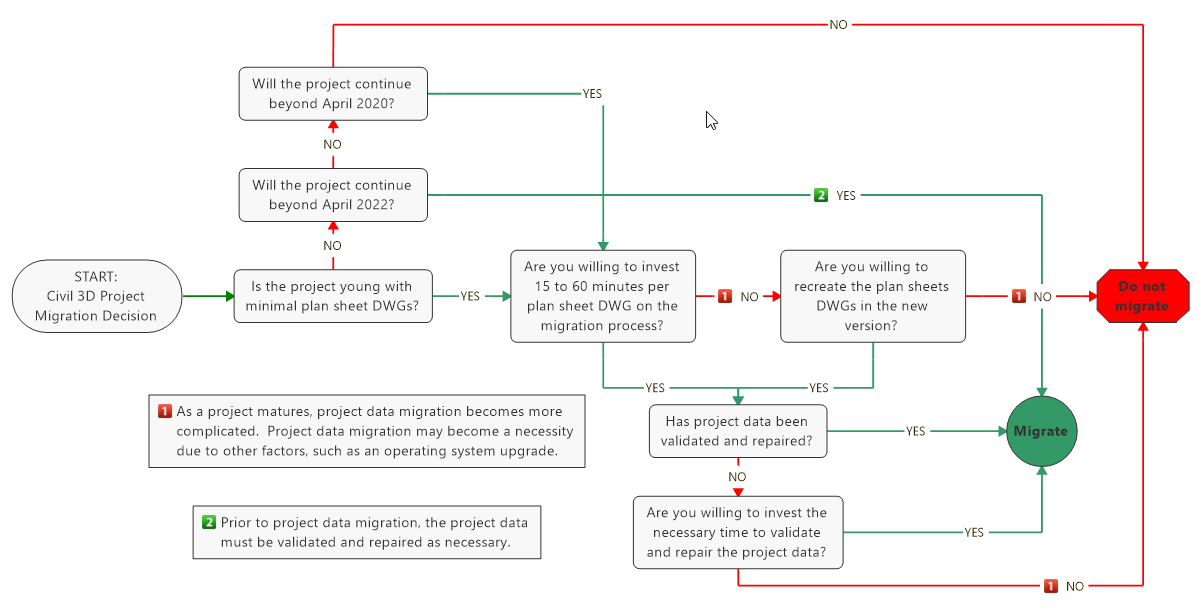
The decision whether or not to migrate a project is not a black and white issue. Some additional factors to consider for the timing of a project migration include:
- The benefits of new software functionality and WisDOT standards may or may not outweigh the costs of migration.
- The completion level of design and the timeline to PS&E submittal are critical to this decision. If project deadlines (30% submittal, 60% submittal, PS&E, etc.) could be jeopardized by the migration taking longer than expected, the project should not be migrated.
- Project size and complexity will increase the level of effort necessary to migrate the project.
- All people working on the project in Civil 3D must have the version of software being migrated to and are aware of the migration.
- The expected time commitment to migrate the project can be absorbed by the design team.
Important potential changes between Civil 3D versions
This Civil 3D version change is referred to as a migration because of these primary factors:
- Each version may use a different drawing format
- There may be no backward compatibility between Civil objects and dynamic capabilities
- Subassemblies use different source code files and are recompiled with a new path
- Data shortcut functionality may have changed
- Project drawing files cannot be worked on while Edits to the Data Shortcuts files and accompanying drawings are being made
- Changes to the WisDOT standards files and locations may be appreciably different in the latest version
New drawing format
Civil 3D 2018 uses a 2018 DWG file format. In simple terms, Civil 3D uses the DWG file not only as a place to store graphical information, it also treats the DWG as something like a database file. To accomplish new functionality the files are written differently and new elements are added to the 2018 DWG files that do not exist in previous DWG versions.
The migration process relies on creating a copy of all Civil 3D files and Data Shortcut files in a new location and migrating the originals to Civil 3D 2018. The copied original Civil 3D files are to be used for troubleshooting needs that may arise, and to ensure functionality was intact prior to the project migration into the 2018 format.
No backward compatibility
Warning: Since there is no backward compatibility of Civil 3D objects between the two DWG formats, there is no ability to turn a 2018 drawing back into a fully functioning drawing in a previous version without a lengthy rebuild process. Success with a rebuild is not guaranteed to fully succeed.
Before beginning the migration to Civil 3D 2018
The time it will take to transfer a project will vary depending on:
- Number of drawings
- How many drawings are consuming xrefs
- How many drawings are being xref'd
- The number of data shortcuts and drawings hosting data shortcuts
- The condition and version format of the original drawings
The Data Shortcut project needs to be reviewed and corrected in its current version prior to the project migration.
Additional time should be expected to ensure the project is fully cleaned. All drawings and data shortcuts need to be working properly prior to going through the various migration steps outlined in the following section.
Only those working directly on the migration of the project data should be opening any of the drawings during the migration process. It is recommended that there should be a minimum number of persons involved in doing the migrating tasks, preferably one person. Most projects contain drawings that are under the ownership of various individuals or sections (PDS, Survey, Plats, etc). It is important to communicate the project migration plan to each party involved and confirm their time commitment if they will be the ones performing the migration for their files.
The transfer is complete when all useable DWG files are saved in the 2018 format and a project integrity check has been accomplished.
 Clean and fix project drawings and references
Clean and fix project drawings and references
Verify that all Data Shortcuts, Data Shortcut References, and External References within the project are working properly. Use the following steps as a guide to ensure that they are clean and working correctly. These steps require a working knowledge of file management and Project Data shortcut tools.
Project Data Shortcuts
These steps are required to be done in the project's current version. It is not recommended to migrate or use any of the project drawings and reference files that are not fully functional in the version they were initially created in.
- All Data Shortcuts must by synchronized and working properly
-
Open the Data Shortcut project in the Civil 3D Prospector without project drawings open
Tip: This may require communication with the entire project team
- Right click- Validate Data Shortcuts
- Expand the entire Data Shortcut tree for each object, and search for any exclamation symbols

-
Use the right click menu to Remove or Repair Broken Shortcuts

- An additional dialog box may prompt to Repair All Broken Shortcuts > YES
- This may repair the rest of the broken Shortcuts in the project
- Search for any more Exclamation symbols in the Data Shortcut tree in the Prospector tab
- Close and reopen Civil 3D to save Data Shortcut edits
Drawing data shortcut references
Civil 3D 2016 includes a tool to assist users in repairing broken data shortcut references within a drawing. Information on how to use the Data Shortcut Manager is published on Autodesk's website. Data Shortcut Manager. Use this tool on the project drawings to repair and update data shortcut references prior to migrating a project.
In drawings that contain external references, it is a best practice to review the external references manager to ensure correct pathing and resolve any missing references. This topic is covered here: Repair external references
Batch Save Utility to repair project drawings in their current version
- Exit all versions of Civil 3D
- Windows Start Menu > Autodesk > Civil 3D Batch Save Utility
- Choose current Civil 3D project version. If the project being migrated is currently in Civil 3D 2016, choose Civil 3D 2016.
- Under Custom Script, choose defaultClean.scr from the drop-down menu. The script will purge registered applications, purge all unused resources and audit each drawing in addition to saving Keeping Drawings Clean
- If there are any directories that you would like to exclude from the process, choose them by clicking Exclude
- Under the Skip Drawings section it is recommended to only check the "Read Only" box
- Under the Process Settings it is recommended to only check the "Timeout for a drawing" box (set to 10) and the "Process Simultaneously" box (set to 4)
- Start Depending on the number of files this could take some time.
-
Log to verify all drawings were successfully processed

- There may be cases where drawings fail. Options include:
- Open the drawings manually and clean (Purge, Purge RegAps, Audit) Keeping Drawings Clean
- If problems persist contact CAE Support
 Project drawing migration
Project drawing migration
Make a copy of the project before migrating
Save a copy of the entire project. The minimum for this is to create a copy of all the Civil 3D DWG files and Data Shortcut files. This project copy should be outside of the original project location, and outside of the project folder used to define the Data Shortcut project, store on a local drive or flash drive. Leave this copy of the project in its current version. Use the original project location to migrate to 2018. This will be the same folder structure for most projects. (i.e. N:\PDS\C3D\12345678)
When migrating a project to a version that has a newer drawing format (ie. Civil 3D 2016 to 2018), it is important that ALL drawing files that are being used as external references (xrefs), Data References, and Sheet production drawings be saved as a Civil 3D 2018 drawing.
Tip: Important Note: It may not be necessary to migrate drawings or files to the new version if they are not going to be used (directly or via reference) in further project development and can be archived and PDF deliverables created from them.
Save to Civil 3D 2018
Utilize the Autodesk Batch Save Utility to save all the project drawings to Civil 3D 2018.
- Exit all versions of Civil 3D
- Start > Autodesk > Civil 3D Batch Save Utility
- Target: Civil 3D 2018
- Custom script: qsave.scr
- Add the project folder within the Include area. If there any directories that you would like to exclude from the process, choose by clicking the Add button in the Exclude area
- Under the Skip Drawings section, only check the "Read Only" box
- Under the Process settings Check "Timeout for a drawing" (set to 10) and "Process Simultaneously" (set to 4)
- Start Depending on the number of files this could take some time.
- Log to verify all drawings were successfully processed
- There may be cases where drawings fail. Options include:
- Open the drawings manually and save them to Civil 3D 2018.
- If problems persist contact CAE Support
Migration order of operations
Info: For migration, best practice is to start with source drawings (ie. BaseData, RW), follow up with design drawings that are XRef'd into plan sheets, and finish with plan sheet drawings.
Convert plot style to CTB
Prior to WisDOT's implementation of Civil 3D 2018, all previous versions utilized drawings with STB Plot Style Tables. With the release of Civil 3D 2018, WisDOT has made the transition to CTB formatted drawings. Follow these steps to convert a drawing from STB to CTB. This process only needs to be completed for plan sheet drawings and drawings that are attached as an external reference (XRef) into plan sheet drawings.
- PSTYLEMODE Enter
- If it is 0 then it is STB and needs to be converted
- If it is 1 then continue to "Use Layer States to Update DWG Layers"
-
CONVERTPSTYLES Enter , Ok

- The drawing is now a CTB format > Save
Use Layer States to update DWG layers
Prerequisite: The drawing must be converted to CTB prior doing this step. This process only needs to be completed for plan sheet drawings and drawings that are attached as an external reference in plan sheet drawings.
- Save the current layer state. This will be useful for drawings with non-standard drawing layer settings.
WisDOT Sheets ribbon > Plot Configuration panel > Unsaved Layer State drop-down > New Layer
State
- In the dialog box, name the layer something that is easy to recognize (Original-Pre2018) > Ok
This Layer State can be used later to restore custom layer settings if they exist

-
WisDOT Sheets ribbon > Plot Configuration panel > Layer States

-
The Layer States Palette will open. If it doesn't click the Palettes On/Off button on the left end of any WisDOT ribbon

- Click on WisDOT18 All Layers(default) from the Layer States Palette to load the Layer State into the drawing
-
Home ribbon > Layers panel > Layers

-
Unsaved Layer State > Manage Layer States

-
Layer States Manager
- Select the WisDOT18 All Layers(default) layer state from list of options.
- Uncheck the following boxes:
- Restore options
- Turn off layers not found in layer state
- Layer properties to restore
- On/Off
- Frozen/Thawed
- Locked/Unlocked
- Restore options
-
Restore

-
The layers now have been successfully translated to WisDOT Civil 3D 2018 Standards. To verify proper translation, Home Tab > Layers Panel > Layer Properties Manager.
-
2016 WisDOT Layer Standards (STB Format): Notice the named plot styles in the Plot Style column

-
2018 WisDOT Layer Standards (CTB Format): Notice the grayed out and color_** named Plot Styles. In this drawing type, the plot color is driven by the color of the layer. Also, notice the index color numbers for some of the layers mostly including the existing layers. If you do not see the Plot Style column, right click on the title bar (Name, Linetype, Plot Style, etc) and select Restore All Columns to Default.

-
- Update External References. Before proceeding with this step, all external reference drawings must be updated to CTB and Civil 3D 2018 Layer settings.
- Create a Layer State for the current layer settings
- Home tab > Layers panel > Layers Properties
- In the Filters > expand Xref
Right-click the target drawing name > Reset Xref Layer Properties > All Properties
 Pipe network drawings
Pipe network drawings
Info: This is only required for drawings that contain pipe network objects (Source or Data Reference)
Add updated parts list to old drawings. This process updates the WisDOT parts lists in the drawing. If you previously made any edits to these parts lists, those edits will be overwritten with this process.
-
WisDOT Design ribbon > Pipe Network Utilities > Add WisDOT Parts List

 Import updated Civil 3D styles
Import updated Civil 3D styles
Info: This is only required for plan sheet drawings and their external references.
Many styles have been updated in Civil 3D 2018. Follow these steps to get the latest style definitions. If you previously made edits directly to any WisDOT-provided styles (vs making a copy), this process will overwrite those edits.
-
The drawing must be saved prior to starting this process.
-
Manage ribbon > Styles panel > Import

-
In the dialog box, navigate to C:\WisDOT\Stnd\C3D2018\Templates\Begin-dwg\design-wisdot18.dwt or applicable template (ie. Design, Survey, Plats, Construction Survey). Click Open to load the template. Civil 3D will compare the loaded template to the currently open drawing.

- Once the dialog box opens, leave everything checked as defaulted. Import settings should NOT be checked.
-
OK

-
OK

- The drawing styles are now updated
 Cross section drawings #cross
Cross section drawings #cross
In Civil 3D 2018, slight adjustments were made to the Group Plot Styles and Section View Styles to allow for the section views to be placed closer together on a cross section sheet. Drafting Buffers have also been introduced in Civil 3D 2018 and allow annotation objects to be "connected" to section views (Drafting Buffer Information).
Section View Drafting Buffer
Info: The following is required for migrating cross section drawings from Civil 3D 2016 to Civil 3D 2018.
Warning: When opening a Civil 3D 2016 cross section drawing in Civil 3D 2018, a drafting buffer gets added to each section view with a default size that is not editable. For this reason, the drafting buffer is turned off in the Group Plot Styles when opening a 2016 drawing in C3D 2018. When importing the updated WIsDOT Group Plot Style, the drafting buffer will be turned on. This results in one view on each cross section sheet.
After importing updated Civil 3D styles to a cross section file, the group plot style for the cross section views will need to be updated to keep the section views organized as originally set up.
- Home Ribbon > Toolspace > Settings > Section View > Group Plot Styles
-
Right Click > Edit any Group Plot Styles that are noted to the left of the style name by the yellow dependency triangle.


-
In the Group Plot Style edit dialog, open the Array tab, and uncheck the "Add drafting buffer size to space between views."
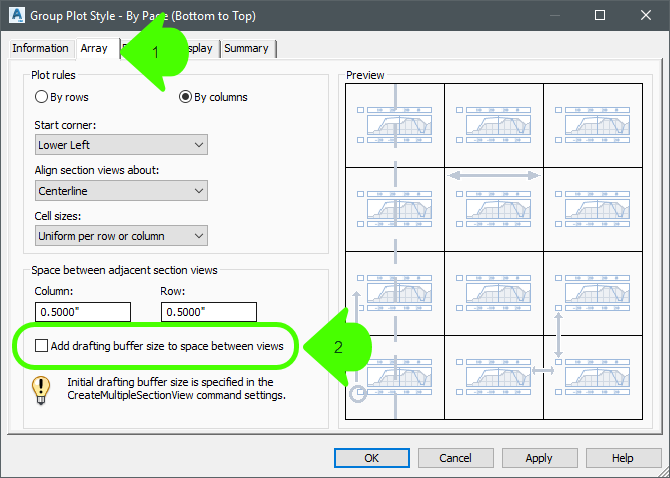
- OK to close the dialog.
- The Section View Group Layout will be updated. Due to the smaller spacing for the Group Plot Style and Section View Style, the section views will be placed closer together than what was done with Civil 3D 2016. If desired, follow the next section to update the styles to move the section views to pre-Civil 3D 2018 spacing.
Section View and Group Plot Styles
Info: The following is optional for cross section drawings.
Warning: The adjustments made to the section view styles and group plot styles in Civil 3D 2018 result in slight movement of the section views that were made in Civil 3D 2016. Any annotation objects will not move with the section views.
After modifying the group plot style in the previous section, the section view group layout will update and the section views will be placed closer together than what was developed in Civil 3D 2016. If desired, the styles can be updated to reflect the Civil 3D 2016 standards. This is not required for complete migration, it is up to the project staff to decide if this is needed for the cross section drawings. Possible reasons to complete these steps include:
- Annotation objects such as labels and Mtext were created in the original cross section view locations and no longer line up with the section view.
- Since section views are placed closer together, there may be less section sheets than layouts, and some layouts might be empty.
The following describes updating the Group Plot Styles and the Section View styles to reflect the Civil 3D 2016 standards
- Home Ribbon > Toolspace > Settings > Section View > Group Plot Styles
-
Right Click > Edit any Group Plot Styles that are noted to the left of the style name by the yellow dependency triangle.


- Group Plot Style edit dialog > Array tab
-
Change the Space between adjacent section views to 1" for each option.
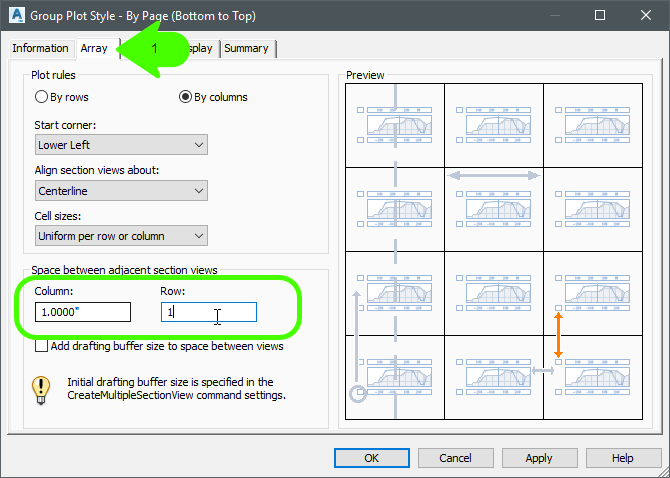
- OK
-
- Home Ribbon > Toolspace > Settings > Section View > Section View Styles
-
Right Click > Edit any Section View Styles that are noted to the left of the style name by the yellow dependency triangle.

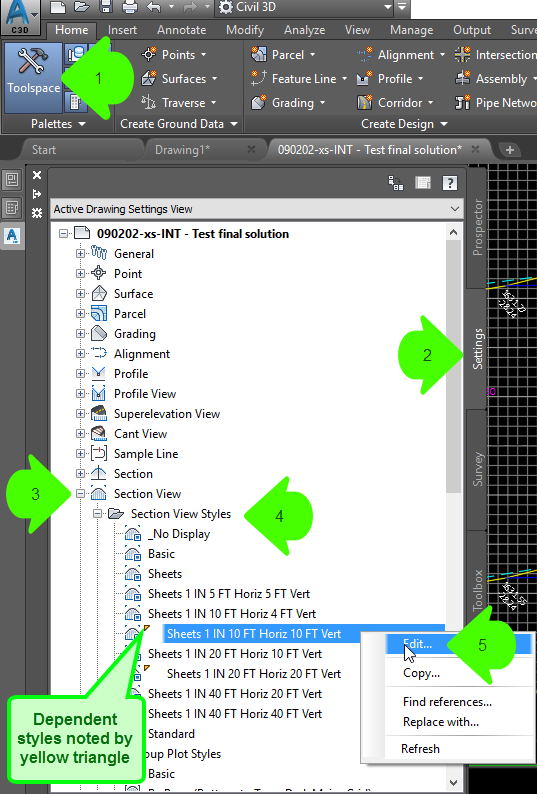
- Section View Style dialog > Grid tab
-
Change the Axis offset above and below to 0.50".
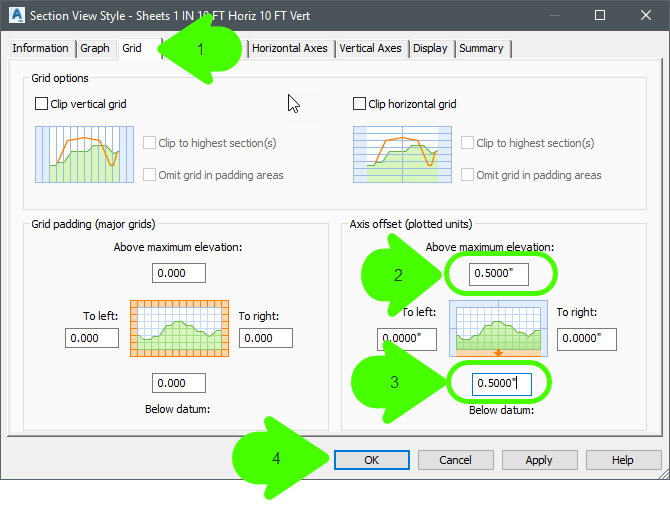
- OK.
-
-
The Section View Group layout may not update automatically. To update the layout, select one of the section views in model space, either by picking on an elevation or offset axis label. From the contextual ribbon, pick Update Group layout.
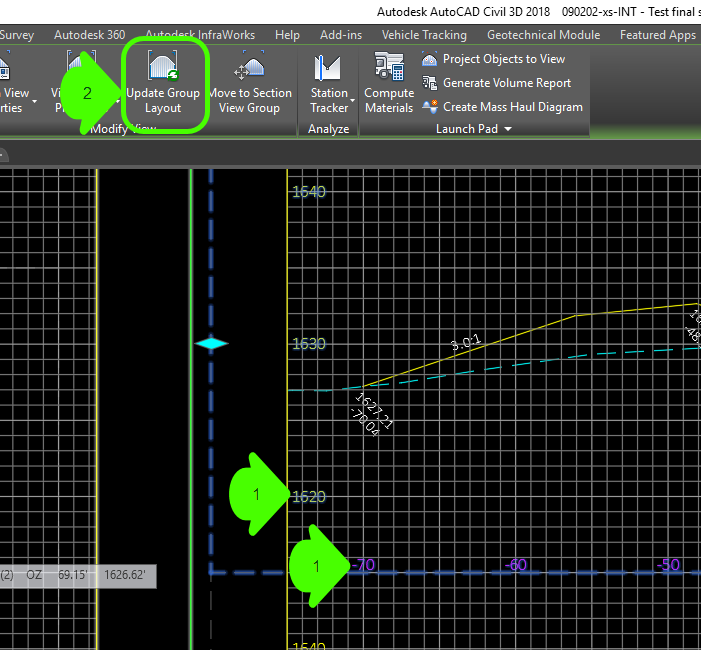
 Add Civil 3D 2018 updated components
Add Civil 3D 2018 updated components
It is recommended that for plan sheet drawings, the updated Civil 3D 2018 components be added to get the latest versions of Dimensions, Layers, Linetypes, Marker Symbols, Multileaders, and Text Styles.
If only some objects are desired, those objects can be added using the buttons under the "Add Component" pull-down. If all objects are needed in the drawing, the "Add All Components" button can be used.

 Insert page setup and update layouts
Insert page setup and update layouts
Requirement: This is required for drawings with plan sheet layouts
Drawings that contain plan sheet layouts may contain page setups that will not plot correctly with the 2018 standards. When the drawing is converted to CTB, the plot style tables set in the existing layout's page setups are removed. Updated page setups that match WisDOT's Civil 3D 2018 standards need to be applied to all layouts in a drawing.
-
WisDOT Sheets tab > Plot Configuration panel > Page Setups

Tip: If you do not see the tool palettes click the Palettes ON/OFF on the left side of the panel.
-
Page Setups Tool Palette > PDF-11x17-stnd to load the WisDOT Civil 3D 2018 plan sheet page setup into the drawing.

-
If the page setup being imported contains the same name as a page setup already in the dwg, this message will appear- Yes

No to update all layouts

- To verify that the page setup has been properly assigned, use the Multi-PageSetup tool to assign the newly loaded page setup to the layouts within the drawing.
-
WisDOT Sheets tab > Plot Configuration panel > Multi-PageSetup

- Refresh All to update both lists on the palette
-
Select all the layouts that require the updated Page Setup. Also, select the updated Page Setup in the second list. Use Shift-Select or Control-Select to pick different layouts.
-
Apply to apply the updated Page Setup to the selected layouts.
- Navigate to a layout and verify a layout is plotting in black and gray scale. If the page setup assignment is incorrect, the layouts will plot color.
 Updating a corridor drawing
Updating a corridor drawing
This is only required for drawings that contain corridor objects.
The following sequence should be applied to each project corridor drawing saved to Civil 3D 2018.
Warning: These steps should not be taken until all other steps in the sections above have been completed.
- Open the corridor drawing in Civil 3D 2018
- Synchronize all Data Shortcuts
- If the Event Viewer has been populated through any of these first steps, all events should be cleared before proceeding.
- Rebuild the corridor. If the Event Viewer shows events, clear Event Viewer and then:
- Corridor Properties dialog > Parameters tab
- Uncheck all regions.
- Apply to rebuild the corridor with no regions constructed.
- Recheck all the regions.
- OK to rebuild the corridor with all regions constructed.
- Check the construction of the corridor in plan and corridor section editor.
- Corridor Properties dialog > Parameters tab
-
In the rare case where the Event Viewer still shows events, review the Warning Descriptions, looking for: ".Net subassembly project, module, or class not found". If this error is found, please email Methods Development at support.cae@dot.wi.gov

- If the drawing has more than one corridor, follow steps 4 and 5 for each corridor
- Repeat steps 1-6 for each drawing that has corridor.
- Save after each corridor rebuilds and before closing the drawing.
- Once corridors are built, verify all data references are rebuilt in the drawing.
- Save and Close.
 Legacy objects (Pre-2016)
Legacy objects (Pre-2016)
Refer to Demonstration: Options for preparing legacy dwgs for use with the WisDOT C3D 2018+ plot style table #demo for additional information for updating legacy objects